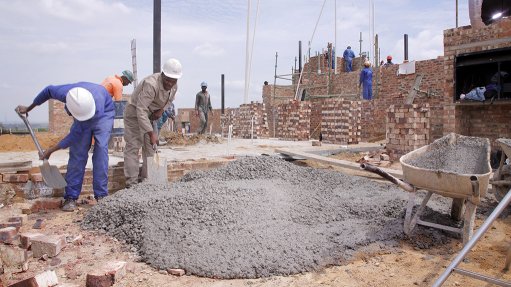South Africa’s space sector hobbled by lack of support
South Africa’s space sector has been hobbled by a lack of adequate support from the South African government. This was made clear during a panel discussion on space technology at the recent Aerospace, Maritime and Defence Conference 2017, in Pretoria. “Most space programmes, worldwide, have been supported by governments,” pointed out Department of Trade and Industry (DTI) legal and compliance chief director for special economic zones and space affairs Nomfuneko Majaja. “It needs a strategic decision . . . for a national [space] programme. Once a national programme has been decided, it must be funded.”
South African national space agency (Sansa) Space Engineering quality specialist Eduardo Jorge Pinto highlighted that a national space strategy for the country had been published near the end of 2010. But it has never been approved. This space strategy, he observed, proposed that the country spend R1-billion a year for ten years on its space programme. “We’re spending nowhere near that . . . The political will is not there.” (Space Engineering is one of Sansa’s four directorates.)
Part of the blame, however, had to reside with the local space sector itself. “In the space sector, one of the capabilities we lack is putting forward the business case for space,” said Denel Dynamics programme manager Patrick Ndlovu. “We have a long way to go to perfect our [marketing] strategy.” (Denel Dynamics includes the group’s space technologies business, Spaceteq.)
“We are very good engineers, but bad at budgeting; we refuse to acknowledge that the rand [exchange rate] is up and down. That is bad; we need a mechanism to deal with this,” affirmed Pinto. “Our supply chain procedures are terrible. There is too much red tape. One of the things we need to achieve as soon as possible] is to ensure those proceedings are . . . simple.”
But space is important to the country. Ndlovu noted that information processing was a key component of the Fourth Industrial Revolution, and that space technologies were a “key” source of information. Satellites, Pinto averred, were used “to support critical decision-making by government.” Space data, used in what is called space applications, is used to support agriculture, land use, urban planning and disaster management, among many others things. “The capabilities we have in space applications is enormous,” asserted Majaja. “With these applications we can do things much better, much simpler, much faster.”
The country has already built and has launched two satellites (not counting CubeSats, also known as nanosatellites). “By building satellites, we encourage industry, we bring in modern manufacturing methods,” explained Pinto. “We create centres of competence, centres of excellence. We do research and development.” This all stimulates innovation.
Majaja elucidated that the DTI had a two-fold role with regard to space. “The DTI serves in a regulatory role, through the Space Council. Over and above that, the DTI is responsible for industrial development. . . . So we do have some [space industrial] capabilities in the country. “All we have to do is ramp up [and] invest more in such capabilities, so that we can have a sustainable space programme.”
The Space Council is formally titled the South African Council for Space Affairs. Its functions are to advise the Minister of Trade and Industry on international obligations regarding space affairs, to ensure local compliance with international space obligations, to license South African space activities and to establish and maintain a register of domestic space capabilities. Sansa Space Engineering is concerned with space system and subsystem development and integration. It is currently responsible for overseeing the project for the country’s next satellite, the earth observation EOSat-1. Denel Spaceteq is focused on executing the EOSat-1 project (having been awarded the contract for the satellite in 2014, with launch-ready delivery in early 2019).
Comments
Press Office
Announcements
What's On
Subscribe to improve your user experience...
Option 1 (equivalent of R125 a month):
Receive a weekly copy of Creamer Media's Engineering News & Mining Weekly magazine
(print copy for those in South Africa and e-magazine for those outside of South Africa)
Receive daily email newsletters
Access to full search results
Access archive of magazine back copies
Access to Projects in Progress
Access to ONE Research Report of your choice in PDF format
Option 2 (equivalent of R375 a month):
All benefits from Option 1
PLUS
Access to Creamer Media's Research Channel Africa for ALL Research Reports, in PDF format, on various industrial and mining sectors
including Electricity; Water; Energy Transition; Hydrogen; Roads, Rail and Ports; Coal; Gold; Platinum; Battery Metals; etc.
Already a subscriber?
Forgotten your password?
Receive weekly copy of Creamer Media's Engineering News & Mining Weekly magazine (print copy for those in South Africa and e-magazine for those outside of South Africa)
➕
Recieve daily email newsletters
➕
Access to full search results
➕
Access archive of magazine back copies
➕
Access to Projects in Progress
➕
Access to ONE Research Report of your choice in PDF format
RESEARCH CHANNEL AFRICA
R4500 (equivalent of R375 a month)
SUBSCRIBEAll benefits from Option 1
➕
Access to Creamer Media's Research Channel Africa for ALL Research Reports on various industrial and mining sectors, in PDF format, including on:
Electricity
➕
Water
➕
Energy Transition
➕
Hydrogen
➕
Roads, Rail and Ports
➕
Coal
➕
Gold
➕
Platinum
➕
Battery Metals
➕
etc.
Receive all benefits from Option 1 or Option 2 delivered to numerous people at your company
➕
Multiple User names and Passwords for simultaneous log-ins
➕
Intranet integration access to all in your organisation


















